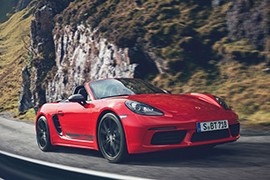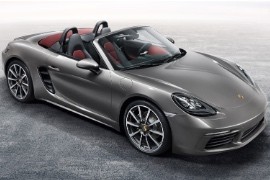PORSCHE 718 Boxster Models/Series Timeline, Specifications & Photos
First production year: 2016
Engines: Gasoline
Body style: Convertible (spider/spyder, cabrio/cabriolet, drop/open/soft top)
Porsche introduced the Boxster T in late 2018 for the 2020 model year, mixing the chassis of the GTS version of this nameplate with the two-liter turbocharged flat-four engine of the regular Boxster.
While most of the advanced technical features of the Boxster were available for the S and the GTS versions, the base model was restricted to just a few. As a result, customers who didn’t want, or could not get, those upgraded models had to rely on the standard suspension and transmission of the base version or have just a few improved parts. But then, the German sports car manufacturer reconsidered its decision and created the 2020 Porsche Boxster T. This vehicle still had the same powerplant as the entry-level version of the roadster but was lighter and with much better suspension featuring PASM. But there was more than just a better suspension.
On the outside, the T version featured a new pair of headlights carried over from the Boxster GTS. Their black background made the four LEDs of the daytime running lights look brighter. Also, the lower bumper was borrowed for the most potent version of the Boxster, featuring a different styling than the one from the base version of the open-top vehicle. It had two oblique slats towards the center that made the air intake between them look angry. At the same time, the side scoops sported the turn signal lamps and the parking lights on their upper sides.
The low-slung profile of the Boxster T couldn’t pass unnoticed, thanks to the 20 millimeters (0.8 of an inch) ground clearance that came with the improved suspension. In addition, a set of decals adorned the car’s fenders and door panels, featuring two black lines and sporting the GTS lettering. These came with the black package that added dark 18-inch alloy wheels. Out back, the smoked LED taillights flanked the black badge of the 718 Boxster T. Ever since the model’s launch in 1996, all the Boxster (non-S) versions came with a single oval or trapezoidal exhaust. This was the first to feature dual pipes, also carried over from its more potent siblings.
Porsche had a long history of creating T-versions, where the letter came from “Tourism.” It targeted customers who wished to travel more with their cars, feel their lightweight construction, and still enjoy a few amenities. The Boxster T followed the same principles. It featured red pull-straps instead of door handles, two-way adjustable seats, and many Alcantara-covered areas, although Porsche named them as Spor-Tex. These materials covered the door cards, the steering wheel, the seats’ center sections, and the gear selector (for PDK-equipped models). Fronting the driver was a unique instrument cluster where the center-mounted tachometer that sported the T letter on the dial. On the center stack, the car manufacturer placed a seven-inch PCM infotainment system, and customers could upgrade to a more powerful sound system made by Burmeister.
The flat-four turbocharged engine of the Boxster T had the same 300 PS (296 hp) as the entry-level Boxster, and Porsche paired it with either a six-speed manual or a seven-speed (dual-clutch) PDK gearbox. That helped the automaker lower the production costs of the car, but it still offered enough pleasure for those behind the wheel. All the oomph was sent to the rear wheels via a mechanical locking differential.
It was the beginning of a new era for the Porsche Boxster, one when the magic sound of the flat-six engine was replaced by the one provided by a turbocharged flat-four, albeit that wasn’t necessarily bad news.
Porsche complicated things a little bit more when it introduced the fourth generation of the Boxster in 2016. While it sported the 718 commercial nameplate, it had the factory internal code of 982, which followed the 981 that was the Boxster’s third generation. The 718 nameplate was carried over from the automaker’s history that scored a 1-2 finish at the 1970 24 Hours of LeMans race. Porsche honored that victory when only seven cars completed the race, with three Porsches on the podium (the third was an older 908 racer). The brand’s fans appreciated the new designation of the Boxster, the car that saved the German automaker. Even though the 2016 model relied on the same chassis as its predecessor, most of its body panels were new.
At the front, there was a new set of LED headlights that sported four blocks for the daytime running lights that used the same light-emitting diode technology. On the lower side of the bumper, Porsche installed a new apron that featured a trapezoidal-shaped air intake in the middle and flanked it with a pair of scoops adorned by three horizontal slats and the parking lights plus the turn signals on their upper side. It wasn’t a revolutionary design compared to its predecessor, but it looked better, mostly thanks to the redeveloped headlights.
From its profile, the low-slung front of the 718 Boxster resembled its predecessor, especially due to the side-mounted turn signals stuffed between the front bumper and the wheel arches. Moving on to the sides, the automaker created new doors and side sills that grabbed more air and diverted it to the air intakes that cooled and fed the mid-mounted engine. Another noticeable difference was for the door handles, which were without recess covers. Porsche also installed new 18-inch alloy wheels, with an option for a 19-inch set. At the back, the automaker completely redesigned the deck. It featured a deployable wing, which looked like a lip spoiler when lowered. In addition, the new LED taillights were fresh and sported red horizontal stripes for the brake lights. Finally, under the lower side of the bumper, the 718 had a single exhaust, like all its non-S Boxster predecessors.
Porsche was known for its high-quality interiors, and the 718 Boxster 982 was no exception. Its tall seats with integrated headrests were leather-wrapped and featured high-bolstered areas. As an option, customers could get even sportier seats. On the center stack, the automaker placed a seven-inch touchscreen for the PCM (Porsche Communication Management) infotainment system. The new unit supported Apple CarPlay but not Android Auto. However, drivers were more concerned about their driving position and the instrument panel. For the former, there were plenty of adjustments, including for the steering wheel. For the latter, the automaker relied on the same three-dial setup as on the 781 generation of the Boxster, where the tachometer took center stage and was flanked by the speedometer on the left and by a 4.6-inch color display on the right.
Porsche ditched the six-cylinder engine for the 2016 Boxster (782) and replaced it with a turbocharged four-cylinder. Thanks to its advanced engineering and knowledge about turbocharging, the new powerplant provided more power and torque than the previous 2.7-liter flat-six, even though it had just a two-liter displacement. Furthermore, it could rev above 7,000 rpm, which was unusual for an engine fitted with forced induction. Porsche paired the new unit with either a six-speed manual or a seven-speed automatic (dual-clutch) PDK transmission.

